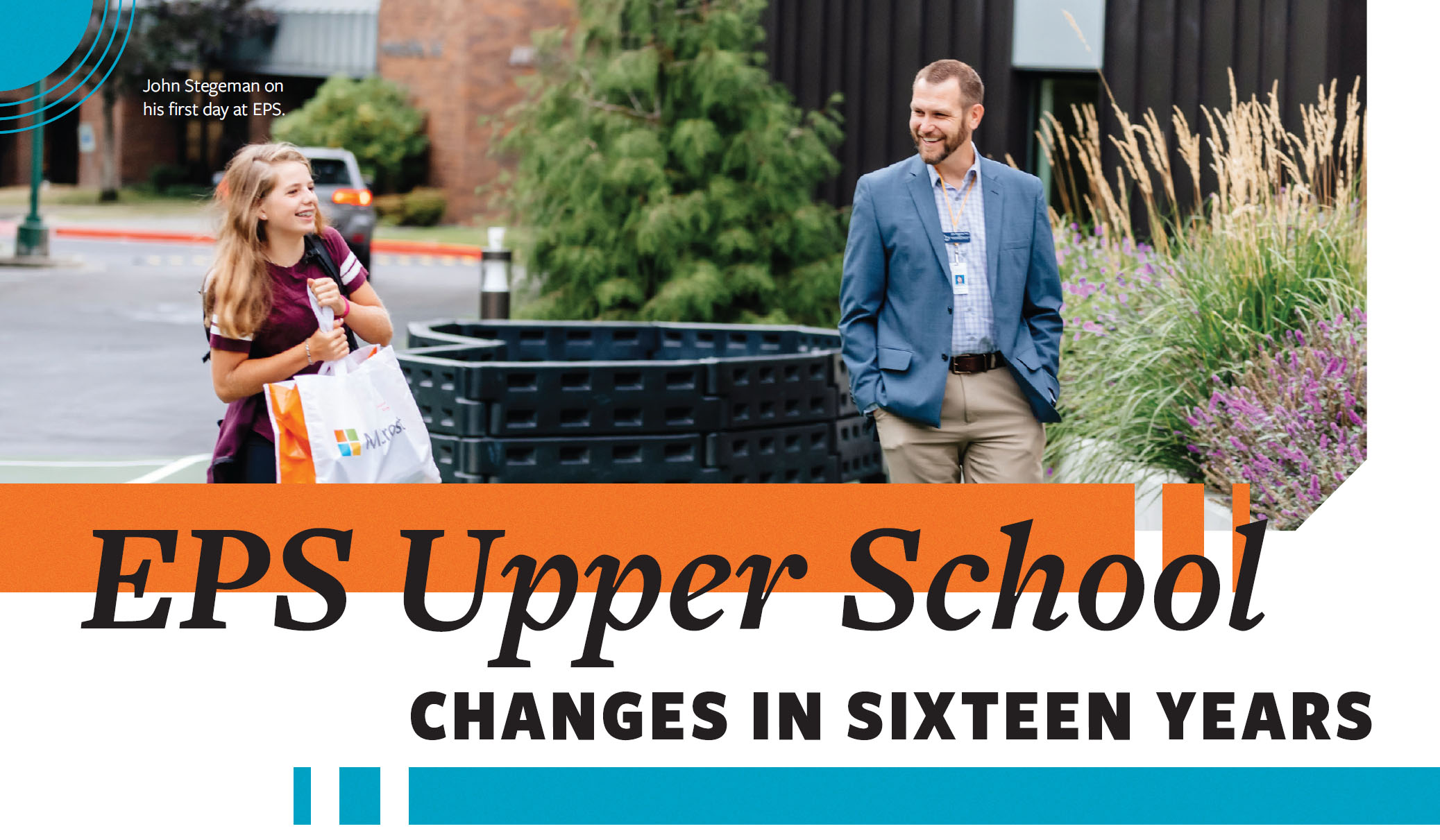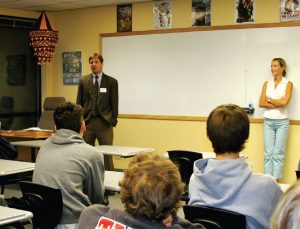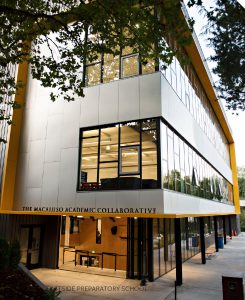
By Bart Gummere, Associate Head of School for College Counseling and Alumni Relations
and Dr. John Stegeman, Head of Upper School
When Bart Gummere came to Eastside Prep to be Upper School Head in 2006, the division numbered just twenty-three students total in grades nine and ten. John Stegeman took over the role in 2019. At that time, there were approximately 285 students in the Upper School. The division has since reached full enrollment of 332 students, approximately eighty-five in each grade.
The Upper School has come a long way in sixteen years. Despite differences in size, available resources, and academic programming, a distinctive EPS culture and many features of the program have held constant. In this interview, Bart and John reflect on their time at EPS and compare the Upper School, then and now.
WHAT STOOD OUT AS SPECIAL ABOUT EPS WHEN YOU FIRST ARRIVED?
JOHN: From the first moment I set foot on campus, I knew there was something special about this school. EPS has a vibe. It’s hard to describe because it’s more like an energy you can feel than a specific or observable thing. I noticed that people smiled a lot. They seemed busy—the place was bustling. But people took time to stop and talk—to me and to each other. I could tell that people genuinely liked one another. They enjoyed working together and collaborating. They could finish one another’s sentences. That doesn’t happen unless people spend a lot of time together and really share a lot of mutual experiences and respect.
BART: There was so much work to be done when I first got here. But what excited me was the entrepreneurial spirit you felt throughout the place. From the students, parents, board members, faculty and of course, Dr. Macaluso, there was such a strong sense of ownership. People believed in this venture and put their collective heart and soul into its success.
WHAT WERE THE CHALLENGES YOU FOUND WHEN YOU ARRIVED?
BART: Wow. Where to start! We had only one year of curriculum established when I started. Actually, in the spring of 2006 when I was hired but was still with my previous school, I flew out to work on our combined ninth and tenth grade paired literature and history courses. We hammered out the framework in a day, and that program became one of our signature academic pieces, providing a remarkable level of choice to students in a very small school. Through my early years, we were constantly developing new courses and obviously hiring many teachers. Finding people who had the right spirit and work ethic to fit was probably the most important challenge we faced.
Here at EPS, we were exceptionally open to changes and small enough to be very nimble. That intersected well with a time in which education was ripe for change.
JOHN: The school was approaching full size, which meant that running the division was a lot of work. Many of the operational systems had been built when there were far fewer students, and in ways that prioritized flexibility and personal solutions. I knew we needed to find some efficiencies and create some standard practices, but we couldn’t sacrifice the personal touch or stop meeting each student where they were in their unique educational journey. So the challenge was to build protocols that made sense for most students in most situations, but retain the ability to make exceptions when warranted. One way to do this was to create a process for students to petition for an exception to an academic policy. I often find myself telling students “everything is petitionable,” but then guiding them to justify their request with a good reason.
WHAT WERE THE OPPORTUNITIES THAT STOOD OUT THEN?
 BART: The development of people and curriculum was our biggest challenge AND it was our biggest opportunity. I was fresh from a successful, well-established school that was not particularly flexible in its approach. Making large changes in that environment was so difficult. Here at EPS, we were exceptionally open to changes and small enough to be very nimble. That intersected well with a time in which education was ripe for change. For years, schools had instilled knowledge largely via students’ command of facts. Now most of those facts could be looked up on a phone in a matter of seconds. Instead, students need to learn how to use and analyze facts. Sounds simple, but we needed to reshape the classroom, the delivery of information, and the manner in which we assessed student learning.
BART: The development of people and curriculum was our biggest challenge AND it was our biggest opportunity. I was fresh from a successful, well-established school that was not particularly flexible in its approach. Making large changes in that environment was so difficult. Here at EPS, we were exceptionally open to changes and small enough to be very nimble. That intersected well with a time in which education was ripe for change. For years, schools had instilled knowledge largely via students’ command of facts. Now most of those facts could be looked up on a phone in a matter of seconds. Instead, students need to learn how to use and analyze facts. Sounds simple, but we needed to reshape the classroom, the delivery of information, and the manner in which we assessed student learning.
JOHN: Numbers and resources create lots of opportunities. As we’ve grown, we have more of both. I think the benefits of this are really easy to see in our athletics program, where in just the last few years EPS teams have become competitive on the regional and national level in several sports. EPS also has a reputation for academic excellence that goes beyond Seattle; we’re one of the top schools on the West Coast now. That brings a lot of pressure, for us as teachers and school leaders, and for students who can feel the pressure of rising expectations from their parents, teachers, and classmates. The real opportunity here, I think, is for us to remain the kind of place where high performance coexists with joy and the exhilaration of working at the top of your potential. I don’t want EPS to become a pressure-cooker kind of school where all the freshness of learning a new skill or idea is overshadowed by tons of homework and academic stress.
WHAT ARE YOU MOST PROUD OF THAT YOU HELPED DEVELOP IN YOUR TIME AS UPPER SCHOOL HEAD?
JOHN: Well, since COVID hit in my first year, I’d have to say that our pandemic response has been ever-present in my time here. The part of that I’m proud of is that we have come through this crisis of monumental proportions as an intact community. What I mean is that we’re still talking to one another. We still trust one another, and like one another. I’ve been through crises at schools before, and I’ve seen irreparable rifts develop between the faculty and school leaders, or between one subset of the parent community and another. That hasn’t happened here. Part of that is due to Dr. Macaluso’s leadership. She made sure we pivoted quickly when we needed to, but not before considering every side of each issue. But another part of it stems from every individual in the community taking time to check in with one another, to ask how people are doing. We’ve tended to our relationships, and I’m proud to be one of the people who contributed to that important work.
BART: Through everything, we never lost sight of the most important detail: our people. Our largest priority is to turn out not just educated people but high-quality people. As I work now with our alumni, I see we’ve done just that. EPS students and alumni are kind, considerate, and curious people. That started with the priorities we set early on. And the faculty shares those qualities. It is no coincidence the graduates turn out this way.
WHERE WOULD YOU HOPE THE SCHOOL DEVELOPS IN THE FUTURE?
 BART: I hope we remain nimble and open to change. Once a school experiences the degree of success enjoyed here, it can be easy to get satisfied. I have no crystal ball on what EPS will need to look like in twenty years. I just know the answer won’t be that it’s the same as today.
BART: I hope we remain nimble and open to change. Once a school experiences the degree of success enjoyed here, it can be easy to get satisfied. I have no crystal ball on what EPS will need to look like in twenty years. I just know the answer won’t be that it’s the same as today.
JOHN: This is a time of great transformation in the independent school world and in higher education. I think EPS is well-poised at the leading edge of many of those changes. Technology, for sure, is part of this evolution, and we’re very fortunate to have incredible infrastructure and a lot of tech-forward and tech-savvy teachers. I also think we are about to see some really important developments related to student well-being and sustainable human performance. We’ve recently seen Olympic athletes come out and talk about the toll their sports have taken on their mental health. Our students put forward an equivalent level of training and preparation for their studies, and they do it in six or eight different subjects every other day. I want EPS to make sure our students are supported holistically as they develop, and I want us to make colleges recognize that our students not only perform at a high level, but they do it in a way that doesn’t sacrifice their well-being. Rather, they are growing stronger all the way through.
ARE THERE ANY MEMORIES OR ANECDOTES THAT STAND OUT TO YOU AS PARTICULARLY INSIGHTFUL INTO YOUR EXPERIENCE AS UPPER SCHOOL HEAD?
JOHN: Oh, wow—tons! I guess some of the best are also the freshest. I got to spend a lot of time with the Class of 2022 this year. We started the year on a rafting trip up on the Skagit River. It was a blast—jumping off the boats, paddling, and swimming through some rapids. And then this spring, we spent three days in Port Townsend on the Senior Retreat. We had bonfires on the beach and just enjoyed each other’s company. One of the seniors made a late-night pasta dinner for everyone. I was worried about this group last year because they had missed out on most of their junior year and they were feeling pretty down about the year ahead. But they really came through and rebuilt the EPS experience for themselves and brought the rest of the Upper School along with them. It’s been a privilege to watch them grow and recover from such a huge disruption. It gives me hope for the future.
BART: It is hard to overstate the limitless nature of the Upper School Head position. There is never a point in working with students, parents, and colleagues in which more time would serve no purpose. Trying to meet all those needs in the scope of a normal workday was (and is) incredibly challenging. I recall in my second year feeling a bit overwhelmed as I walked late into yet another meeting with Dr. Macaluso. She pointed out that I was doing well and that I was late because I was doing my job. That pausing to be present with people is far more important than checking anything off from some to-do list. That has stuck to this day.

